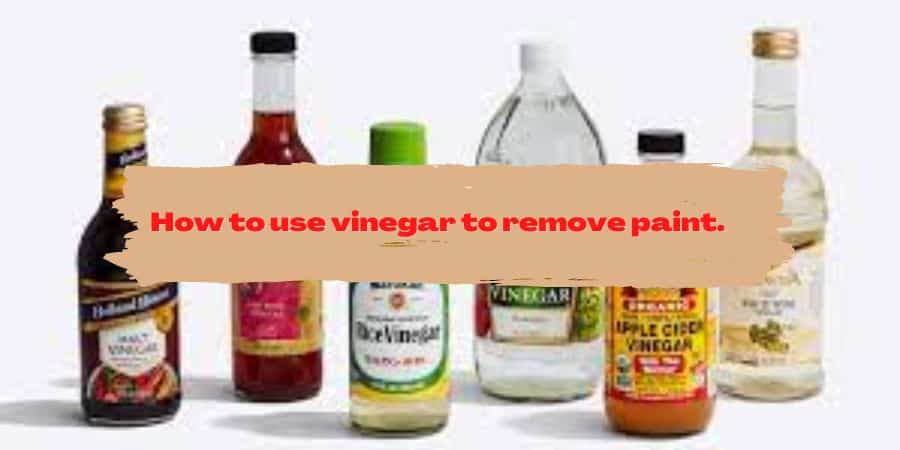Learn through this blog post, whether using vinegar will remove the paint from surfaces, including metal, wood, plastic, concrete, and tiles or not?
Vinegar is a versatile compound. Found in kitchens as it makes good pickles and adds delicious taste to our daily meals.
If you didn’t already know, it is good for cleaning too.
Will vinegar remove paint?
Regardless of the type used, oil-based or latex-based (water-based).
Vinegar can remove both types of paints.
Just like other paint strippers, it softens the paint coat by breaking the molecules by initiating a chemical reaction.
When it gets softened, use any scraper, sandpaper, or regular cloth to remove the paint from the surface.
However, there are some limitations to removing the paint.
Vinegar is capable of performing the desired effect depending on the type of surface.
From Plastic
Usually, surfaces of plastics are very flat, difficult for applied vinegar to sit longer.
Therefore, to remove paint from a plastic surface, the best option is to use any dedicated cleaning products that you can find in the markets, or at Amazon.
However, vinegar will also do a fine job but you should know how to apply it properly.
Mainly, while scraping off the paint, don’t apply too much pressure so that the surface would not get damaged.
So to remove paint from a plastic surface.
- Boil some amount of white vinegar ½ cup, in a pan to increase the density. You may also mix baking soda to make an even powerful mixer to remove paint.
- Cool it down and dab a piece of cotton cloth.
- Spread the heated vinegar on the surface needed to clean the paint.
- Leave it for 5-10 minutes so the vinegar will do the trick- make the paint softener.
From Metal
Vinegar is not a good way to remove paint from metallic surfaces.
Because vinegar contains about 8% acid in total volume. This causes metals to corrode, causing them to rust.
- However, aside from the cons, vinegar surely removes the paint from metal. But the amount of vinegar to spread should be kept minimum to avoid the metallic surface getting rust.
From concrete
If you want to remove or clean paint from a wall of concrete.
It is best to use a combination of vinegar and baking soda for concrete walls.
Using vinegar alone might not be the solution that can remove the paint since paint sticks tightly to concrete.
- Put ½ cup vinegar in a bowl and mix 1 spoon of baking soda. It should look like a paste. Next, dampen a piece of cloth in the mixture.
- Apply the mixture to the concrete surface. Leave it still for at least 5-10 minutes. So when the paint gets softened, you can check by touching the surface. Use a scraper to peel off the paint coat, it would be easy now.
From wood
Removing paint from wooden items, such as a floor or any furniture item is easy by using vinegar.
As it can soften any paint regardless of oil and water in 10 minutes.
Moreover, wood does not get any harm when using vinegar yet it’s a beneficial and environmentally friendly option to use to clean paint from wood.
From tiles
To remove paint from tiles. Cleaning agents like baking soda should be mixed with vinegar to ensure maximum strength.
Secondly, make sure the vinegar or mixture sits on the surface for about 15-20 minutes which is possible when you turn a liquid vinegar into a paste by heating and mixing baking soda.
What is vinegar?
Vinegar is made from acetic acid and trace compounds that may contain different flavors.
But all Vinegar typically contains 5–8% acetic acid by volume.
And that acidic property is the key factor in removing the paint.
- The acetic acid property of kinds of vinegar is usually produced by a double fermentation process; yeast converts simple sugar to ethanol and acetic acid bacteria convert ethanol to acetic acid.
How to use vinegar to remove paint.
- Step.1 Prepare Vinegar Solution- First you will need to prepare a vinegar solution. Heat 0.25 ounces of your white vinegar in a safe container. Let it simmer in approximately 0.25 – 1 cup of water. You can mix other cleaning agents with the vinegar solution for an increase in strength. Baking soda is one of the products you can use.
After boiling and preparing the mixture. Cooldown the mixture by turning off the heat source.
- Step. 2 Dampen a cloth- Dip a cotton cloth into the mixture of vinegar Or you can use a paintbrush as well. After dampening, squeeze some mixture out.
- Step.3 Applying vinegar- Using your heated vinegar as our next step, we will remove the paint completely. Cover the identified paint using warm vinegar by using a damp cloth. It takes about 10 to 15 minutes for the paint to meltdown after being soaked.
Usually, the paint will peel off or will be softened in the first attempt. In case it does not work. Repeat the process to clean off the paint thoroughly.
- Step.4 Use a scraper to peel off the paint- At this point, conversely after leaving the paint for about 20 minutes. It should get softened. Now you can move on to the next step, which is using a scraper to scratch the painted surface.
If you apply just gentle pressure and make a few quick motions, there will be no significant damage to the surfaces.
Depending on how stubborn the paint is, you may need to soak the swab in more vinegar.





